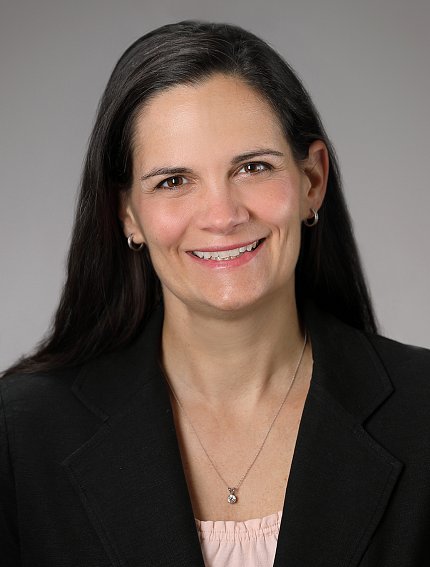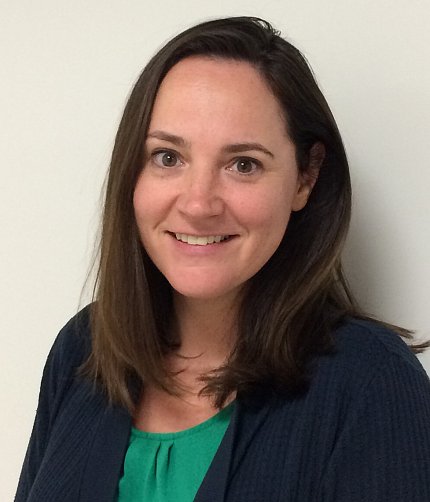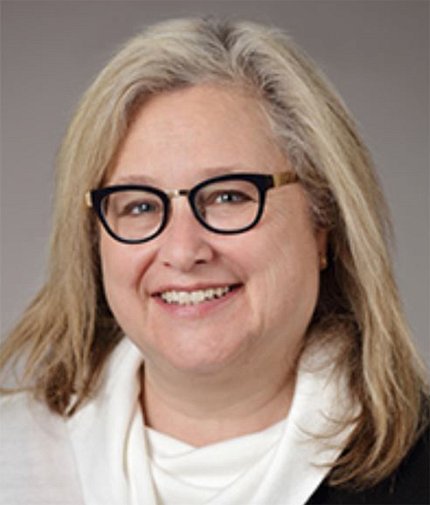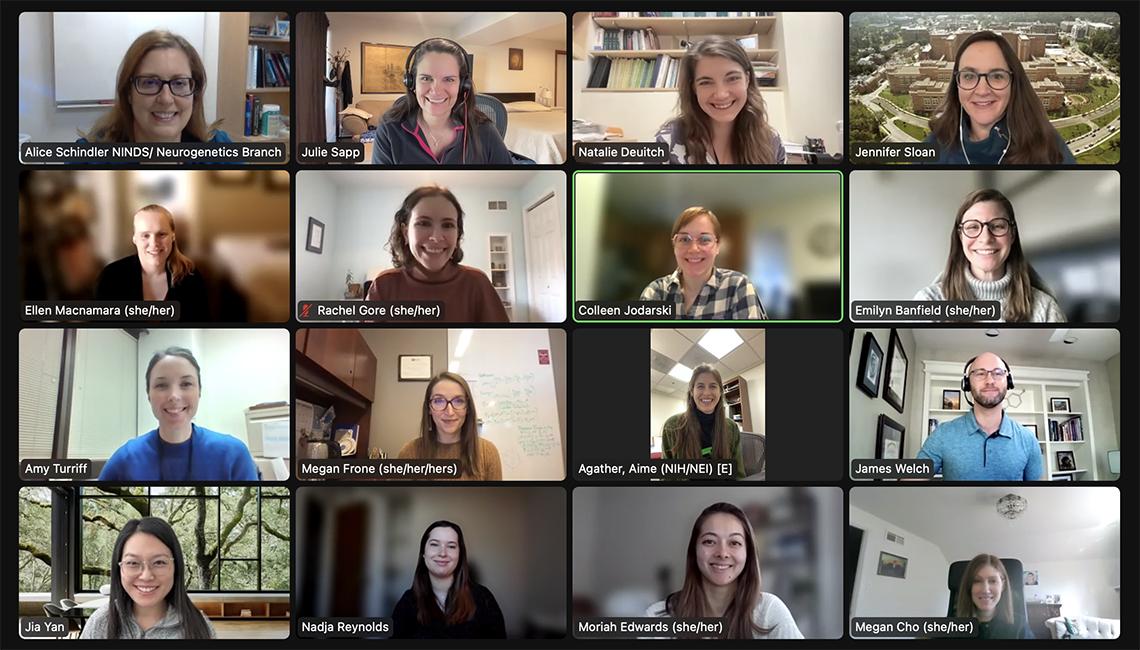Becoming Better Helpers
Genetic Counselors Meet to Support Patients, Each Other

Genetic counselors (GCs) provide critical support to patients and caregivers during what often are long, complex medical journeys. Sometimes, GCs also need to guide and support each other.
At NIH, GCs work with patients who have rare, often life-threatening diseases. Like their patients, GCs have diverse needs and would benefit from the expertise of multiple counselors. But there’s no single department for GCs at NIH. They come from many specialties and work in different institutes, heightening the need for a collaborative effort.
That effort is the Genetic Counselors Clinical Supervision Group, currently 21 GCs from seven NIH institutes who have met continuously in different iterations for more than 25 years. Each month, they discuss one or two particularly challenging cases confidentially—always protecting the patient’s identity—and receive feedback from GC colleagues across NIH.

“This group has been a source of professional development, support, mentoring and connection for many of us who are not working with other genetic counselor colleagues every day,” said Jennifer Sloan, a molecular geneticist and GC with the National Human Genome Research Institute (NHGRI), who has participated in the group for 18 years and counting.
The GCs find it rewarding to work with colleagues across disciplines.
“I personally know nothing about, say, immune disorders, but my patients with other rare syndromes also live at risk for serious complications and experience progression of their conditions over time,” said Julie Sapp, a genetic counselor at NHGRI. “There are commonalities across all of these patient populations.”
Genetic counselors take on many roles, from guiding patients and families through genetic testing to educating them about their inherited diseases—which often have few if any treatments—and providing psychosocial support. At NIH, they work on a range of conditions—immunodeficiency, cancer, adult-onset neurological disorders and other serious genetic diseases.
“This group gives us a time and space to process these very difficult cases and stories with our peers to help us be better helpers and serve our patients better,” said Sapp.

The monthly meetings allow the group to not only discuss cases, but also self-reflect. “They can talk about counseling and communication skills and refine their skills over time, and [the discussions] help them understand the psychological needs of others,” said Debbie Snyder, senior advisor to the National Institute of Mental Health clinical director, who has worked with the group from the beginning.
Snyder, a social worker with a background in psychiatry and psycho-oncology, conducts psychotherapeutic interventions for medical and surgical patients. She is not, however, a genetic counselor.
Snyder first came to NIH in 1992, a time when the Human Genome Project was well underway and, she recalled, discussions were swirling about whether the GC field should focus more on data or the counseling side or some combination of each.
Three years later, GC colleague Dr. Barbara Biesecker asked her to facilitate a new case-based clinical supervisory group. Eager to bring her mental health perspective to such a setting, she helped launch the group and remains actively involved.
“Genes and all this molecular stuff are not in Debbie’s wheelhouse, and it doesn’t need to be,” said Sapp. “She is the heart and soul of this group. She has this phenomenal institutional knowledge and insights that are crucial.”
Initially, there were three participants. They set the ground rules and over time the group continued to expand. Snyder reflected on why the group is a lifeline to its members.
“If you think about relaying bad news, like a Huntington’s diagnosis, and the challenges of delivering the results—we’re talking about human beings and the threat to health and quality of life and survivability—you need to be able to deploy good counseling skills and communication techniques,” she said. “And you have to know what it means to be a witness to someone’s psychological pain.
“There are opportunities for empathic misses where, if you miss, that will have consequences for how the patients hear and process things and how they communicate back to you,” Snyder said. “This can really impact not only clinical interactions but clinical research as well, not to mention the professional fulfillment and meaning for the genetic counselor.”

A recurring theme in their meetings is how to help patients and families process grief and loss. How do patients cope with impending disability from a progressive disorder? How do they handle the unexpected way their lives turned out and how their disorder might affect their families and future children? How do they manage uncertainty, guilt and stigma?
There are countless questions and emotions GCs strive to help patients identify and manage during their brief encounters—self-disclosure, family dynamics, cross-cultural issues, suicidal ideation.
Then there are the self-reflective, GC-centric matters: empathy, boundaries, burden of work, ethical issues, for instance. “It’s burgeoned into this professional development, well-being group,” Snyder said.
“We talk a lot about our clinical roles,” said Sapp. “NIH exists to generate research that benefits populations...We discuss how to balance [having] meaningful clinical interactions with individual patients and families while also realizing we’re part of teams. We have our own distinct research interests though the goal is not just for the individual to benefit, but the whole population.”
The GCs group kept gathering through the Covid-19 pandemic though, like everyone else, pivoted to virtual meetings.
“I think [the group] became an even more valuable outlet during the pandemic,” said Sapp, “because we had different things to process. Our relationships with our patients differed…we were encountering a new set of challenges.”
Continuing to meet, added Snyder, “was a powerful way to give people a sense of connection and community, reduce isolation, acknowledge a shared experience and manage through the uncertainty as a group, when we couldn’t see each other in person.”
As the GCs come together in the now hybrid environment and work with people who have rare, difficult-to-treat disorders, the hope is always for breakthroughs, and NIH is getting closer to that goal.
“In the last few years,” said Sapp, “we’re starting to see people who are in therapeutic trials, which reflects the degree to which genomics has started to make inroads into therapeutic options, and why NIH is such an incredible place to see these patients.”
The GCs and their NIH colleagues are laying the groundwork for these trials. Sapp is working on a phase 2 trial for a 1-in-10-million disorder; Sloan is working on a gene therapy trial for patients with a life-threatening metabolic disorder.
“We can be even better cheerleaders for the Clinical Center if we not only help our patients adapt better to their medical circumstances, but also bring the same kind of compassion to ourselves and our colleagues,” said Sapp. “We can do work here we can’t do anywhere else, and this group of dedicated GCs helps facilitate those efforts.”
